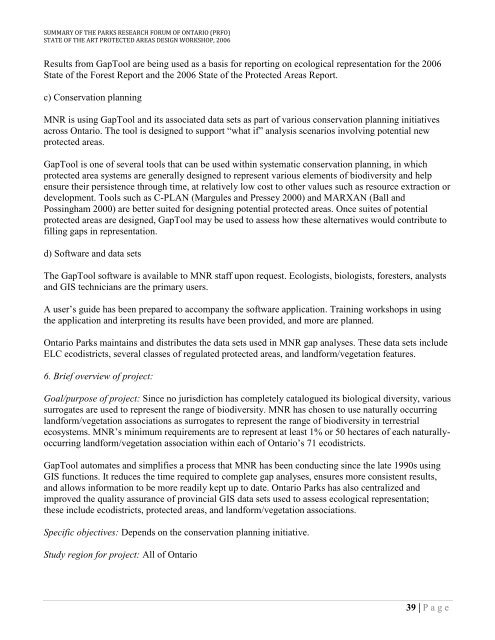Top-Down vs. Bottom Up: Working Towards Consensus ... - CASIOPA
Top-Down vs. Bottom Up: Working Towards Consensus ... - CASIOPA
Top-Down vs. Bottom Up: Working Towards Consensus ... - CASIOPA
- No tags were found...
Create successful ePaper yourself
Turn your PDF publications into a flip-book with our unique Google optimized e-Paper software.
SUMMARY OF THE PARKS RESEARCH FORUM OF ONTARIO (PRFO)STATE OF THE ART PROTECTED AREAS DESIGN WORKSHOP, 2006Results from GapTool are being used as a basis for reporting on ecological representation for the 2006State of the Forest Report and the 2006 State of the Protected Areas Report.c) Conservation planningMNR is using GapTool and its associated data sets as part of various conservation planning initiativesacross Ontario. The tool is designed to support “what if” analysis scenarios involving potential newprotected areas.GapTool is one of several tools that can be used within systematic conservation planning, in whichprotected area systems are generally designed to represent various elements of biodiversity and helpensure their persistence through time, at relatively low cost to other values such as resource extraction ordevelopment. Tools such as C-PLAN (Margules and Pressey 2000) and MARXAN (Ball andPossingham 2000) are better suited for designing potential protected areas. Once suites of potentialprotected areas are designed, GapTool may be used to assess how these alternatives would contribute tofilling gaps in representation.d) Software and data setsThe GapTool software is available to MNR staff upon request. Ecologists, biologists, foresters, analystsand GIS technicians are the primary users.A user‟s guide has been prepared to accompany the software application. Training workshops in usingthe application and interpreting its results have been provided, and more are planned.Ontario Parks maintains and distributes the data sets used in MNR gap analyses. These data sets includeELC ecodistricts, several classes of regulated protected areas, and landform/vegetation features.6. Brief overview of project:Goal/purpose of project: Since no jurisdiction has completely catalogued its biological diversity, varioussurrogates are used to represent the range of biodiversity. MNR has chosen to use naturally occurringlandform/vegetation associations as surrogates to represent the range of biodiversity in terrestrialecosystems. MNR‟s minimum requirements are to represent at least 1% or 50 hectares of each naturallyoccurringlandform/vegetation association within each of Ontario‟s 71 ecodistricts.GapTool automates and simplifies a process that MNR has been conducting since the late 1990s usingGIS functions. It reduces the time required to complete gap analyses, ensures more consistent results,and allows information to be more readily kept up to date. Ontario Parks has also centralized andimproved the quality assurance of provincial GIS data sets used to assess ecological representation;these include ecodistricts, protected areas, and landform/vegetation associations.Specific objectives: Depends on the conservation planning initiative.Study region for project: All of Ontario39 | P a g e


